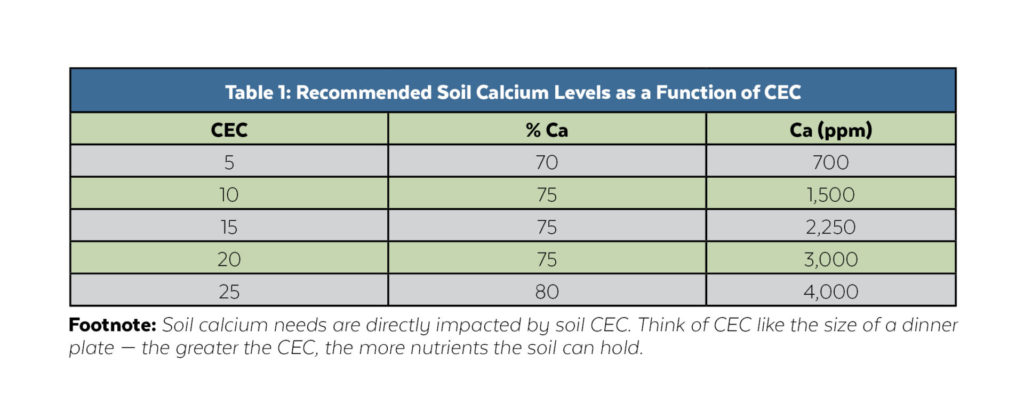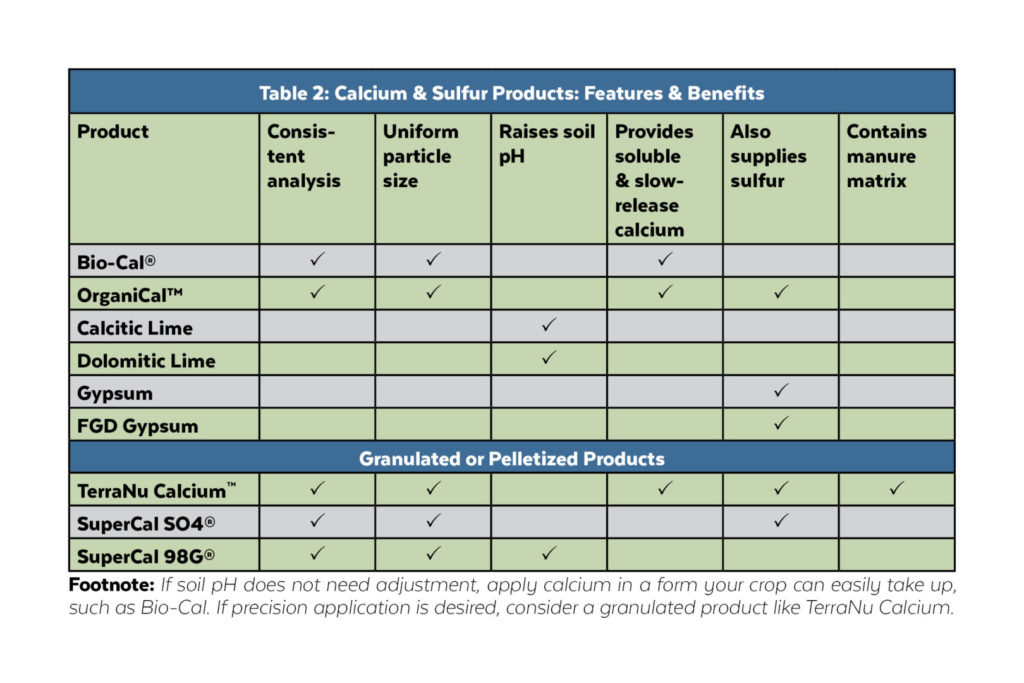Calcium plays a vital role in plant growth, specifically cell wall formation, cell division and pollination. It also signals plants to respond to drought and heat stress, activates many plant enzyme systems and helps plants absorb other nutrients. Calcium also promotes healthy soil structure by loosening soils and stabilizing organic matter, which increases soil water- and nutrient-holding capacity.
When evaluating calcium needs on your farm, we recommend looking at three key factors on your soil test:
- Soil pH,
- Cation exchange capacity (CEC), and
- Percent base saturation of calcium.
Soil pH
Soil pH is a well-understood concept in farming. When pH drops below 6.5, crop growers understand the need for liming materials to increase soil pH and improve nutrient availability.
A common misconception is if soil pH is above 6.5, you don’t need to apply calcium. However, regular calcium application is needed to maintain optimal soil health and plant performance.
Two common liming materials are calcitic lime (CaCO3) and dolomitic lime (CaMgCO3). While both contain calcium, the ability of lime to increase soil pH is actually a function of carbonate (CO3) in the lime. When applied to acidic soils, CO3 reacts and neutralizes acidity, effectively raising pH.
If lime is not needed to raise pH, apply calcium in a form crops can easily take up. Bio-Cal® or OrganiCal™ are both good options for bulk-application calcium sources. If precision application is desired, consider applying a granulated product like TerraNu Calcium™.
Cation Exchange Capacity
Cation exchange capacity (CEC) is a measure of soil’s capacity to hold nutrients. Soils with greater CECs can hold more nutrients, but this may not indicate plant availability. Without knowing CEC, it is difficult to make fertility recommendations because CEC indicates the soil’s potential for crop production.
Think of CEC like a dinner plate — the greater the CEC, the more nutrients the soil can hold.
Percent Base Saturation
Percent base saturation is the percentage of exchangeable potassium, magnesium, calcium, sodium and hydrogen in the soil (total = 100 percent). Growers should maintain a calcium percent base saturation level of 70 to 80 percent for optimum soil conditions and plant performance.
Calcium base saturation levels above 80 percent can mean you’re short on potassium or magnesium. If present, these deficiencies should be addressed through a fertility program. Recommended soil calcium levels as a function of CEC are summarized in Table 1.
Selecting Products
There are multiple calcium products available on the market with varying quality, formulation and physical forms. Commonly applied calcium products and their features and benefits are outlined in Table 2. Once you’ve determined what soil or crop deficiencies you’ll address with your calcium program, selecting the right product becomes much simpler. Other factors, such as available application equipment and tillage methods, must also be taken into account.
Because calcium deficiencies can negatively impact almost every aspect of crop production, it’s important to frequently monitor soil calcium levels. Keep in mind that plant and soil calcium needs vary widely. To ensure plant availability of calcium all season, we recommend applying calcium products that contain multiple sources of calcium like Bio-Cal or OrganiCal for season-long availability. If additional sulfur and organic matter is needed, TerraNu Calcium is an excellent fit.
Interested in more specific recommendations? Contact a knowledgeable BioAg consultant.



